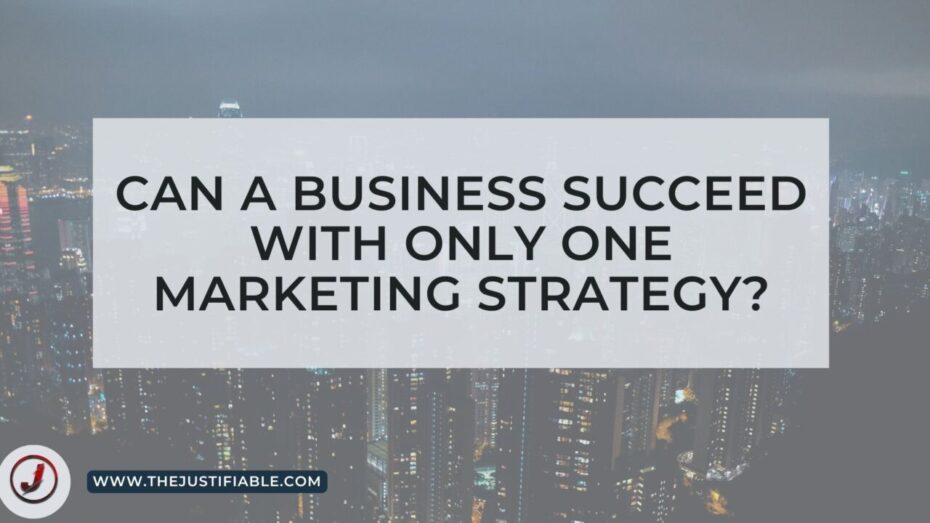Table of Contents
Can a business succeed with only one marketing strategy? Marketing is an essential aspect of every business, as it plays a crucial role in attracting customers, increasing sales, and growing the brand’s reputation.
With the emergence of various marketing strategies, businesses can leverage them to reach their target audience and achieve their objectives.
However, some businesses may wonder if they can succeed with only one marketing strategy. In this article, we will explore the answer to this question and evaluate the advantages and disadvantages of using a single marketing strategy.
The Benefits of Using One Marketing Strategy
Using a single marketing strategy can have several benefits for businesses. The following are some of the advantages:
Simplifies Marketing Efforts
By using one marketing strategy, businesses can simplify their marketing efforts. They can focus on creating and implementing a single marketing plan that aligns with their goals, target audience, and budget.
This approach enables them to streamline their marketing activities and optimize their resources to achieve maximum results.
Consistent Branding
A single marketing strategy helps businesses maintain consistent branding across all their marketing channels. By creating a unified message, businesses can build a strong brand identity and establish themselves as a trustworthy and reliable brand.
Consistent branding also helps businesses to differentiate themselves from their competitors and build customer loyalty.
Cost-Effective
Using one marketing strategy can also be cost-effective for businesses. Instead of investing in multiple marketing channels, businesses can concentrate their resources on a single strategy that yields the best results.
This approach can save them money, time, and effort while providing a high return on investment (ROI).
The Drawbacks of Using One Marketing Strategy
While using one marketing strategy can have several benefits, it also has some drawbacks. The following are some of the disadvantages:
Limited Reach
Using one marketing strategy can limit the reach of businesses. If the chosen strategy fails to resonate with the target audience, businesses may miss out on potential customers who could have been reached through alternative marketing channels.
This limitation can hinder business growth and affect their ability to compete in the market.
Vulnerable to Changes
A single marketing strategy can also make businesses vulnerable to changes in the market. If the chosen strategy becomes ineffective or outdated, businesses may struggle to adapt to the changing market conditions. This vulnerability can put businesses at risk and affect their long-term success.
Inadequate Data
Using one marketing strategy can also limit the data businesses can collect about their target audience. With limited data, businesses may not be able to create targeted campaigns or adjust their strategy based on customer feedback.
This limitation can hinder their ability to improve their marketing efforts and achieve optimal results.
How to Choose the Right Marketing Strategy
Choosing the right marketing strategy can make all the difference in a business’s success. To select the right strategy, businesses need to consider the following factors:
Goals
Businesses should identify their marketing goals and align them with the chosen strategy. For example, if the goal is to increase brand awareness, businesses may want to use social media marketing. If the goal is to generate leads, they may want to focus on email marketing.
Target Audience
Understanding the target audience is critical in selecting the right marketing strategy. Businesses should conduct market research to identify their customers’ demographics, interests, and preferences.
This information can help them choose the marketing channels that their target audience is most likely to use and respond to.
Budget
Businesses need to consider their budget when selecting a marketing strategy. Some marketing channels may be more expensive than others, and businesses need to choose the ones that provide the best ROI for their investment.
Competitors
Analyzing competitors can also help businesses choose the right marketing strategy. By understanding their competitors’ marketing efforts, businesses can identify gaps in the market and create a unique marketing approach that differentiates them from their competitors.
Best Practices for Using One Marketing Strategy
Using one marketing strategy can be successful if businesses follow some best practices. The following are some tips to help businesses make the most out of their chosen marketing strategy:
Create a Detailed Plan
Businesses should create a detailed marketing plan that outlines their objectives, target audience, messaging, and tactics. The plan should also include a timeline, budget, and metrics to measure success.
Having a clear plan can help businesses stay on track and ensure that their marketing efforts are aligned with their goals.
Monitor Results
Businesses should track and monitor the results of their marketing efforts regularly. This monitoring can help businesses identify areas where they need to improve and make necessary adjustments to their strategy.
Monitoring results can also help businesses measure the ROI of their marketing efforts and make informed decisions about future marketing investments.
Adapt to Changes
Marketing is not a static field, and businesses should be prepared to adapt to changes in the market, industry, or target audience.
Businesses should keep up with the latest trends and technologies and adjust their strategy accordingly. By staying flexible and adaptable, businesses can maintain their competitive edge and continue to grow.
Engage with Customers
Engaging with customers is essential in building relationships and creating brand loyalty. Businesses should use their marketing strategy to engage with their customers through social media, email, or other channels.
By listening to their customers’ feedback, businesses can improve their products or services and build a strong customer base.






